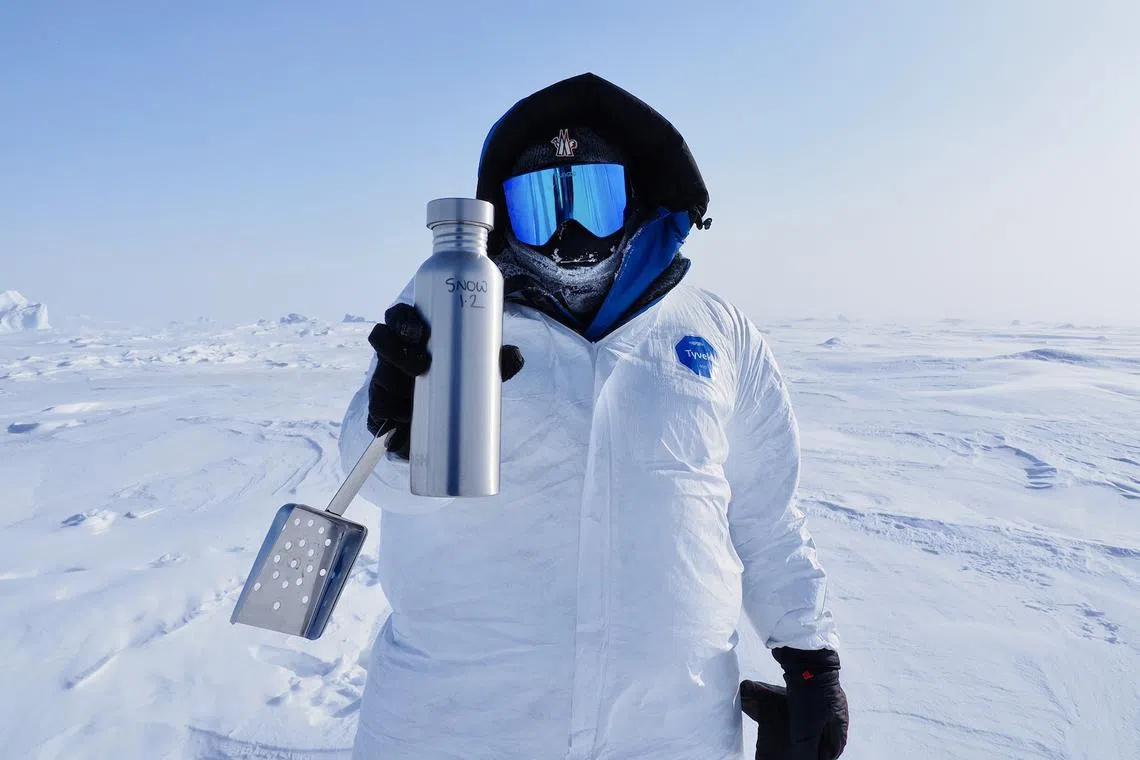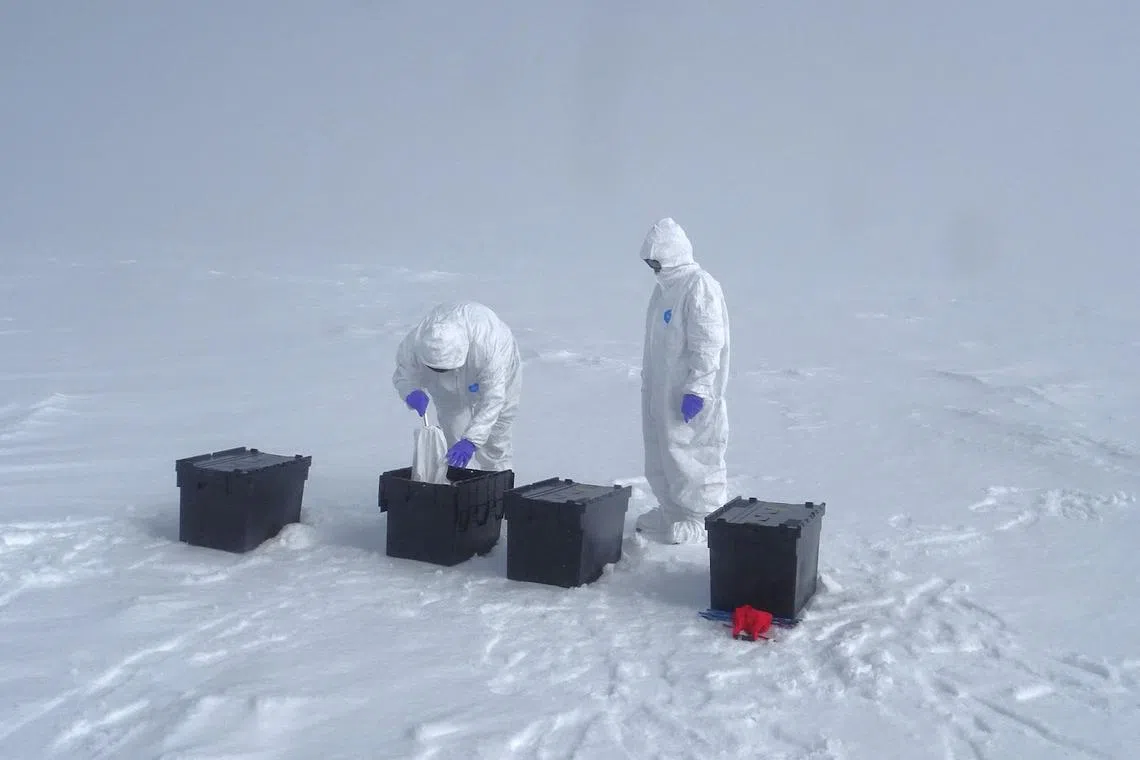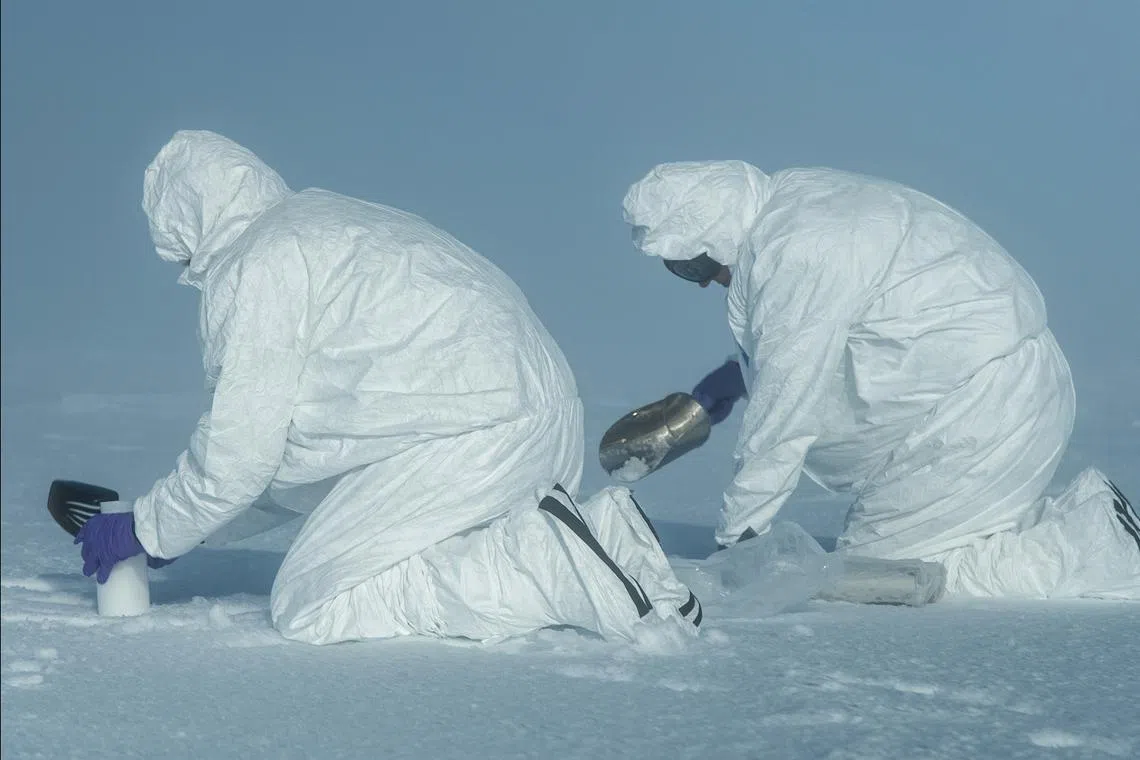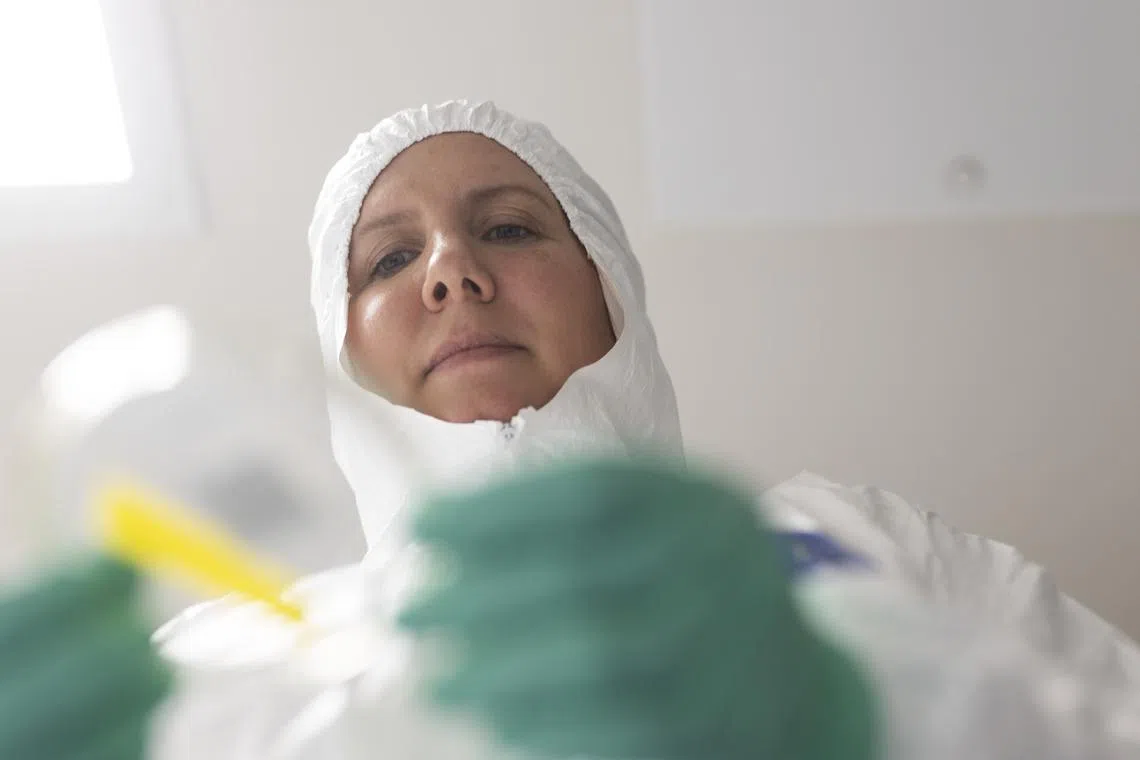IN PARTNERSHIP WITH ROLEX
Gruelling Arctic conditions couldn’t stop her: One explorer’s relentless race to save what’s left before it’s gone
With the Rolex Perpetual Planet Initiative supporting her Before It’s Gone Arctic Research Expedition, Felicity Aston transforms setbacks into breakthroughs as her novice team gathers critical polar data before the sea ice vanishes forever

The Before It’s Gone (BIG) Arctic Research Expedition team pulled sledges loaded with essentials they need to survive and collect scientific samples of ice and water, as well as data points about clouds, albedo and air quality. PHOTO: ROLEX/STEFAN WALTER
Follow topic:
In hot and sunny Singapore, the fate of the icy lands at the poles of the earth may seem like a remote concern.
British polar explorer Felicity Aston understands that but explains: “The Arctic, in particular, is often thought of as a distant white wilderness, but we are all connected to it through the role that it plays for our oceans and atmosphere.”
The Arctic even helps regulate the waters’ temperature, adds the 47-year-old, who has ventured to “all the cold places in the world”, as she puts it, to collect data on them for over two decades.

BIG Arctic Research Expedition founder and polar explorer Felicity Aston has been collecting data on locations across the North Pole, Iceland and Greenland for the last 20 years. PHOTO: ROLEX/STEFAN WALTER
Through her latest project, the Before It’s Gone (BIG) Arctic Research Expedition, she has collected snow, ice and water samples from three different Arctic environments, along with hundreds of data points about their clouds, albedo – the amount of sunlight they reflect, which affects how much of heat they absorb – and air quality.
The National Oceanography Centre at Britain’s University of Southampton, where Ms Aston is a research student, and the United States’ University of Colorado are analysing the samples’ microplastic, lead and black carbon content, among other studies. The results could help to explain why the impacts of climate change are occurring three times faster in the Arctic than anywhere else.
“You can collect some data from space, but there’s certain information you can only get from being there on the ground,” she says of her expeditions. It also struck her that, with the Arctic’s sea ice rapidly receding, scientists are running out of time to investigate and find ways to address the problem.

The BIG team collects crucial sea ice data (a team member pictured collecting snow sample here) that will help scientists better understand climate and environmental change in the Arctic. PHOTO: ROLEX/SADIE WHITELOCKS
“Already valuable in their own right, our datasets together provide a much broader view of the Arctic, which increases their value and rarity,” she adds.
Before the BIG expedition, she has led other trips to the Arctic and Antarctic, Iceland, Greenland and Canada, often with all-women teams. In 2012, she became the first woman to cross Antarctica alone, entering the Guinness Book of Records. Three years later in 2015, she was made a Member of the Order of the British Empire for her services in polar exploration.
While she planned and helmed the voyages, she highlights Swiss watchmaker Rolex’s support for them via its Perpetual Planet Initiative.
It has offered access to its network of Rolex Awards Laureates, comprising scientists, conservationists and others doing their part for Earth’s well-being, and other Perpetual Planet Initiative partners and put her project in the spotlight.
“The Perpetual Planet Initiative has championed people who are really pushing the envelope, not only in understanding our planet, but also how we make it better and provide solutions. Being supported by the Initiative is wonderful in terms of the credibility and community that it brings,” she shares.
BIG Arctic Research Expedition: From setbacks to breakthroughs
For Ms Aston, the BIG project has been the most expansive of her career, which started in 2000, when she was 19. As a fresh graduate with a master of science in applied meteorology, she travelled to Antarctica to work with the British Antarctic Survey as a meteorologist.
Over the next two and a half years, as she recorded data about the region’s climate, she fell in love with the landscape’s “wonderful perfection” and became driven to protect it.

The samples from polar ice and snow in the Canadian Arctic collected by the BIG team will be studied for pollutants to inform what role this region plays in oceanographic trends. PHOTO: SADIE WHITELOCKS
Many polar expeditions followed. Then, in 2015, she was on board a nuclear-powered Russian icebreaker off the North Siberian coast, collecting sea ice data as part of a citizen science programme. When her readings were added to an open database, her entry was the only one from the central Arctic Basin for the year.
She realised that the scientific community needed much more data about the region – and fast. By 2018, the area had lost 85 per cent of its thickest multi-year sea ice. The urgency to save it spurred her to launch the BIG project in 2021, with a novice team.
The original plan was to ski across the Arctic Ocean’s sea ice to the North Pole, gathering ice and atmospheric data along the way. However, the first two attempts in 2022 and 2023 were thwarted by the ice’s failing integrity.
A third in 2024 was cancelled due to insurmountable conditions. In each instance, the team diverted to another Arctic area, where they witnessed drastic changes.

During the expedition to Svalbard in 2022, the BIG team and collected more than 80kg of water, ice and snow samples, like how Ms Aston (pictured) carefully scooped up a snow specimen. PHOTO: ROLEX/SADIE WHITELOCKS
In Svalbard, a Norwegian archipelago in the Arctic Ocean, the team had prepared for expected temperatures of about minus 20 deg C. Instead, the mercury hovered around zero, with rain on most days. The explorers’ equipment, designed for cold weather, became waterlogged, then froze solid when the temperature dropped.
In Drangajokull, Iceland’s northernmost glacier, a valley leading to it that should have been filled with snow was covered in grass. Their sledges and skis became hindrances they had to drag across the dry terrain. Ms Aston recalls: “We were hopping from snow patch to snow patch. It was the biggest challenge of the entire trip.”

Samples and equipment are packed into boxes (pictured are Ms Aston and her team mate and psychologist Laura Thomas) for transport with each 20kg box going on one sled. PHOTO: JULIE MONIERE
Last year, the Canadian Arctic expedition was nearly derailed by consecutive storms that first delayed their start date, then pinned them in their tents once they were on the ice.
When the weather finally calmed just 17 hours before a plane was set to pick them up, they worked non-stop until it arrived and managed to collect all their planned samples.
With the multiple diversions, what was conceived as a single-year journey to the North Pole has turned into a multi-year, pan-Arctic expedition yielding a wealth of samples from different environments.
Ms Aston says of her indefatigable team: “I hope they all feel the scientific contribution that they’ve made as they’re massaging their poor, exhausted muscles.”
Making a BIG impact
Since 2022, Ms Felicity Aston and her team of explorers have collected samples from different Arctic environments as part of the Before It’s Gone (BIG) Arctic Research Expedition. The objective? To help piece together what is happening to the Arctic region. Here are some figures about the BIG project.

The Before It’s Gone Arctic Research Expedition team skiied 48 kilometres from Barentsburg to Longyearbyen in Svalbard to collect polar ice and snow samples. PHOTO: SADIE WHITELOCKS
3 The number of expeditions so far, to Svalbard, a Norwegian archipelago in the Arctic Ocean, Drangajokull, Iceland’s northernmost glacier, and the Canadian Arctic.
More than 200 The number of collected snow, ice and water samples, along with hundreds of other data points.
About 350,000 millilitres Combined volume of the samples, which were all hauled on sledges.
Polar regions in distress: A race against time
As the samples from the expeditions undergo scientific scrutiny, Ms Aston is ready for the findings.
“Most people are aware of marine microplastics now, but airborne microplastics have received less attention. They are being transported around the planet through the atmosphere. We know they are reaching as far as the polar regions. There are all these questions about them and other things that need answering,” she says.

Ms Aston (right) uses a metal scoop to sample for microplastics, while Ms Thomas (left) samples for metal on the surface snow. PHOTO: JULIE MONIERE
With Ms Aston’s tenacity, groundbreaking work and dedication to the environment, Rolex has stepped up to lend its assistance. The firm has supported pioneering explorers like her to push the boundaries of human endeavour for nearly a century.
With climate change and other problems threatening the world’s natural ecosystems, Rolex has shifted from championing exploration for the sake of discovery to protecting the planet, committing for the long term to empower individuals and organisations that are using science to illuminate and address today’s environmental challenges.
It reinforced this engagement in 2019 with its Perpetual Planet Initiative, which initially focused on the Rolex Awards and longstanding partnerships with the National Geographic Society and Mission Blue. Legendary oceanographer Sylvia Earle, who is also a Rolex Testimonee, founded and leads the latter organisation to explore and protect oceans.

Ms Aston holds a sample, one of many sourced from various expeditions that she has led in the Arctic, in the microplastics laboratory at the National Oceanography Centre in Southampton, England. PHOTO: JONATHAN BROWNING
The Initiative now has a diverse and growing portfolio of over 30 partnerships, concentrating on ocean conservation, wilderness protection and the living world’s preservation, including with Rewilding Argentina and Rewilding Chile, which protect landscapes in South Africa, Under The Pole expeditions for underwater exploration, and Rolex Awards
Rolex also advances organisations and initiatives fostering the next generations of explorers, scientists and conservationists through scholarships and grants. These span the Our World-Underwater Scholarship Society and The Rolex Explorers Club Grants that nurture talented young people and enable them to gain experience in their chosen fields, and more.
Ms Aston notes that such support and collaboration are key to conservation efforts, including in the Arctic, where the situation is dire.
She says: “The Arctic Ocean’s sea ice is, year on year, disappearing in front of our eyes. We are determined to contribute to protecting this frozen landscape, which is so critical for sustaining life on our planet. Together, we have a very tangible opportunity to shape the future of the planet into something better.”
We The Earth Rolex and its Perpetual Planet Initiative

